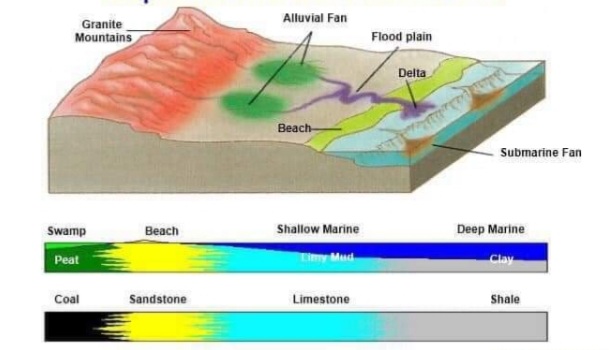Table of Contents
What Are Depositional Environments?
The combination of physical, chemical, and biological processes involved in the deposition of a specific type of sediment and, consequently, the rock types that will be formed after lithification process, if the sediment is preserved in the rock record, are referred to as the depositional environments.

Most of the time, it is possible to compare the surroundings associated with certain rock types or groups of rock types to their existent analogues. However, it is increasingly likely that no direct present analogs exist the further back in geological time sediments were deposited.
Types of Depositional Environments
There are 3 types of depositional environments as listed below.
- Continental
- Terrestial
- Marine
1. Continental
Continental Of course, the name is simplified for your understanding. It concerns all environments on the continent.
Continental environments are listed below.
- Glacial
- Lacustrine
- Fluvial
- Dessert
1. Glacial Environment.
When snow falls on continents and mountainous areas, the snow hardens and turns into ice after a while. Melted water carries sediments, and these deposits are glacial deposits. Snow and ice creep along slopes, carrying sediment and debris and accumulating where it slows down. Since ice can carry sediment to the boulders, it is not screened and is distinguished by unclassified so-called tilite.
2. Lacustrine Environment
Laxtrin is a lake sediment. Sediment deposits in lakes range from coarse to fine depending on the stream’s ability to transport sediment. As for gravity, there is an upward cleanup, as coarse sediment settles first, followed by finer particles. It is coarse at the base and finer towards the top.
3. Fluvial Environment
Fluvial deposits are the water channels deposition. These can be in the streams and rivers. Water manages to carry load from boulder to fine sediments according to the velocity of the water. Boulders are usually carried to a certain distance in a mountain ranges sometimes during flooding the capacity increases where water possess huge velocity. Water dumps it’s load where the velocity breaks As velocity decrease will first deposit coarser sediment and then finer, it also have fining upward succession.
4. Desert Environment
Deserts are places where the average precipitation is less than 25mm/year. Therefore, all deposits in such areas are considered desert deposits. In the desert, the sediments are mostly aeolian. The wind picks up the finer sediment and deposits it elsewhere when the wind speed is interrupted. The sediments are rounded because the corners are rounded due to friction.
2. Terrestrial
These are the environments that exist at the intersection of oceans and continents.
Terrestrial environment are listed below.
- Delta
- Lagoon
- Beach
1. Delta Environment
Delta Sediments are estuary sediments. Rivers carry continental sediment, which is deposited where rivers enter the sea. Coarser sediments are deposited at the early mouth of the estuary, where water velocity breaks down and finer sediments are carried along the water to the sea. Channels exist like the feet of a bird as water moves in different directions.
2. Lagoon Environment
Lagoon is an environment where seawater flows toward land and separates from the body of water. This separated water forms an environment in which sediments accumulate on the continent.
3. Beaches Environment
Beaches Sediment is the terrestrial environment of the earth. Here the sediments are mainly sand grains, with some fine sediments also present.
Ocean.
3. Marine Environment
As the name suggests, it is an ocean sediment and open water body.
Marine environment are listed below.
- Continental Shelf
- Continental Slope
- Open Ocean
1. Continental Shelf Environment
The continental shelf is a shallow marine environment where continental land masses are bathed in water. These environments occur in the ocean as submerged land masses. The continental shelf is heavily deposited with sand, clay, and coral. Coral reefs live in colonial forms and are found mainly on the continental shelf in shallow marine environments.
2. Continental Slope Environment
The Continental Slope is an environment where the continental landmass slopes towards the ocean/ocean. This slope sediment is called continental slope sediment and is a finer sediment. These sediments can be remodeled into open marine environments by turbidity currents.
3. Open Ocean Environment
The open ocean environment is the totality of marine sediments beginning after the continental shelf. These environmental sediments range from fine to coarse, living debris, and basalt. All animals that live in the open ocean are deposited with sediment in the open ocean. These sediments deposit in the ocean.
Conclusion
I have described different types of depositional environments. Each type of environment have unique properties.
I hope you enjoyed my article.
Happy Learning.
Goodbye
